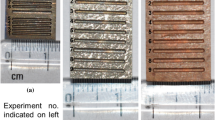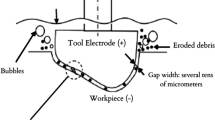Abstract
The machinability of the hybrid machining method for electrical discharge assisted milling (EDAM) has been validated in previous research. The influence of three different dielectrics (kerosene, EDM oil, and deionized water) on the performance of the EDAM was investigated in this study. An analysis of the discharged signal, surface morphology, and elemental composition of the electrode under different machining parameters reveals the influence of different dielectrics. The results show that compared with deionized water, kerosene and EDM oil have a higher discharge frequency. After long-term discharge, debris and carbides will be generated during processing, which will affect the microhardness and discharge stability of the processed material. Among the result of EDAM, EDM oil produced the best surface integrity, with surface roughness values 34.93%, 87.92%, and 121.68% lower than those of kerosene, deionized water, and conventional milling (CM), respectively. The results show that EDAM reduces the microhardness after machining by reducing the plastic deformation of the surface.


















Similar content being viewed by others
References
Li, C. P., Zhao, Y. F., Qiu, X. Y., Li, S. J., Niu, Q. L., Li, P. N., & Ko, T. J. (2022). Interface mechanical damage mechanism in machining carbon fiber-reinforced plastic/Ti stacks based on a three-dimensional microscopic oblique cutting model. Composite Structures, 279, 0263–8223.
Nam, J., & Lee, S. W. (2018). Machinability of titanium alloy (Ti-6Al-4V) in environmentally-friendly micro-drilling process with nanofluid minimum quantity lubrication using nanodiamond particles. International Journal of Precision Engineering and Manufacturing-Green Technology, 5(1), 29–35.
Ortiz, M., Penalva, M., Iriondo, E., & López de Lacalle, L. N. (2019). Investigation of thermal-related effects in Hot SPIF of Ti–6Al–4V alloy. International Journal of Precision Engineering and Manufacturing-Green Technology, 7, 299–317.
Lin, Y. C., Yan, B. H., & Chang, Y. S. (2000). Machining characteristics of titanium alloy (Ti–6Al–4V) using a combination process of EDM with USM. Journal of Materials Processing Technology, 104(3), 171–177.
Woo, W.-S., & Lee, C.-M. (2018). A study on the optimum machining conditions and energy efficiency of a laser-assisted fillet milling. International Journal of Precision Engineering and Manufacturing-Green Technology, 5(5), 593–604.
Sochet, I., & Gillard, P. (2002). Flammability of kerosene in civil and military aviation. Journal of Loss Prevention in the Process Industries, 15(5), 335–345.
Hasçalık, A., & Çaydaş, U. (2007). Electrical discharge machining of titanium alloy (Ti–6Al–4V). Applied Surface Science, 253(22), 9007–9016.
Chung, D. K., Kim, B. H., & Chu, C. N. (2007). Micro electrical discharge milling using deionized water as a dielectric fluid. Journal of Micromechanics and Microengineering, 17(5), 867–874.
Wouters, Y., Galerie, A., & Petit, J.-P. (1997). Thermal oxidation of titanium by water vapour. Solid State Ionics, 104(1–2), 89–96.
Chen, S. L., Yan, B. H., & Huang, F. Y. (1999). Influence of kerosene and distilled water as dielectrics on the electric discharge machining characteristics of Ti–6A1–4V. Journal of Materials Processing Technology, 87(1–3), 107–111.
Zhang, Y., Liu, Y., Ji, R., & Cai, B. (2011). Study of the recast layer of a surface machined by sinking electrical discharge machining using water-in-oil emulsion as dielectric. Applied Surface Science, 257(14), 5989–5997.
Yan, B. H., Chung Tsai, H., & Yuan Huang, F. (2005). The effect in EDM of a dielectric of a urea solution in water on modifying the surface of titanium. International Journal of Machine Tools and Manufacture, 45(2), 194–200.
Zhao, Y., Kunieda, M., & Abe, K. (2016). Comparison on foil EDM characteristics of single crystal SiC between in deionized water and in EDM oil. The International Journal of Advanced Manufacturing Technology, 86(9–12), 2905–2912.
Wang, C., & Qiang, Z. (2019). Comparison of micro-EDM characteristics of inconel 706 between EDM oil and an al powder-mixed dielectric. Advances in Materials Science and Engineering, 2019, 1–11.
Curodeau, A., Richard, M., & Frohn-Villeneuve, L. (2004). Molds surface finishing with new EDM process in air with thermoplastic composite electrodes. Journal of Materials Processing Technology, 149(1–3), 278–283.
Sreeraj, P., Thirumalai Kumaran, S., Suresh Kumar, S., Uthayakumar, M., & Pethuraj, M. (2020). Measurement of micro channels produced in AA6351/Rutile composite by wire-EDM. Surface Review and Letters.
Tang, L., & Du, Y. T. (2013). Experimental study on green electrical discharge machining in tap water of Ti–6Al–4V and parameters optimization. The International Journal of Advanced Manufacturing Technology, 70(1–4), 469–475.
Kibria, G., Sarkar, B. R., Pradhan, B. B., & Bhattacharyya, B. (2009). Comparative study of different dielectrics for micro-EDM performance during microhole machining of Ti-6Al-4V alloy. The International Journal of Advanced Manufacturing Technology, 48(5–8), 557–570.
Wang, X., Liu, Z., Xue, R., Tian, Z., & Huang, Y. (2014). Research on the influence of dielectric characteristics on the EDM of titanium alloy. The International Journal of Advanced Manufacturing Technology, 72(5–8), 979–987.
Zhang, Y., Liu, Y., Shen, Y., Ji, R., Li, Z., & Zheng, C. (2014). Investigation on the influence of the dielectrics on the material removal characteristics of EDM. Journal of Materials Processing Technology, 214(5), 1052–1061.
Li, C., Xu, M., Yu, Z., Huang, L., Li, S., Li, P., Niu, Q., & Ko, T. J. (2020). Electrical discharge-assisted milling for machining titanium alloy. Journal of Materials Processing Technology, 285, 116785.
Li, C. J., Li, Y., Tong, H., Zhao, L., Kong, Q. C., & Wang, Z. Q. (2016). An EDM pulse power generator and its feasible experiments for drilling film cooling holes. The International Journal of Advanced Manufacturing Technology, 87(5–8), 1813–1821. https://doi.org/10.1007/s00170-016-8598-0
Li, C., Xu, X., Li, Y., Tong, H., Ding, S., Kong, Q., Zhao, L., & Ding, J. (2019). Effects of dielectric fluids on surface integrity for the recast layer in high speed EDM drilling of nickel alloy. Journal of Alloys and Compounds, 783, 95–102.
Patel Gowdru Chandrashekarappa, M., Kumar, S., Pimenov, D. Y., & Giasin, K. (2021). Experimental analysis and optimization of EDM parameters on HcHcr steel in context with different electrodes and dielectric fluids using hybrid taguchi-based PCA-utility and CRITIC-utility approaches. Metals, 11(3), 419.
Jamkamon, K., & Janmanee, P. (2021). Improving machining performance for deep hole drilling in the electrical discharge machining process using a step cylindrical electrode. Applied Sciences, 11(5), 2084.
Sultan, T., Kumar, A., & Gupta, R. D. (2014). Material removal rate, electrode wear rate, and surface roughness evaluation in die sinking EDM with hollow tool through response surface methodology. International Journal of Manufacturing Engineering, 2014, 1–16.
Author information
Authors and Affiliations
Contributions
MRX: Experiments, Software, Writing-Original draft preparation; CPL: Conceptualization and Methodology; RK: Measurement and data analysis; JLC: Data curation; TJK: Supervision, Supervision, Funding Acquisition. All authors read and approved the final manuscript.
Corresponding authors
Ethics declarations
Competing interests
The authors declare that they have no known competing financial interests or personal relationships that could have appeared to influence the work reported in this paper. The authors declare the following financial interests/personal relationships which may be considered as potential competing interests.
Additional information
Publisher's Note
Springer Nature remains neutral with regard to jurisdictional claims in published maps and institutional affiliations.
Rights and permissions
About this article
Cite this article
Xu, M., Li, C., Kurniawan, R. et al. Influence of Different Dielectrics and Machining Parameters for Electrical Discharge-Assisted Milling of Titanium Alloy. Int. J. Precis. Eng. Manuf. 23, 1095–1112 (2022). https://doi.org/10.1007/s12541-022-00689-0
Received:
Revised:
Accepted:
Published:
Issue Date:
DOI: https://doi.org/10.1007/s12541-022-00689-0




